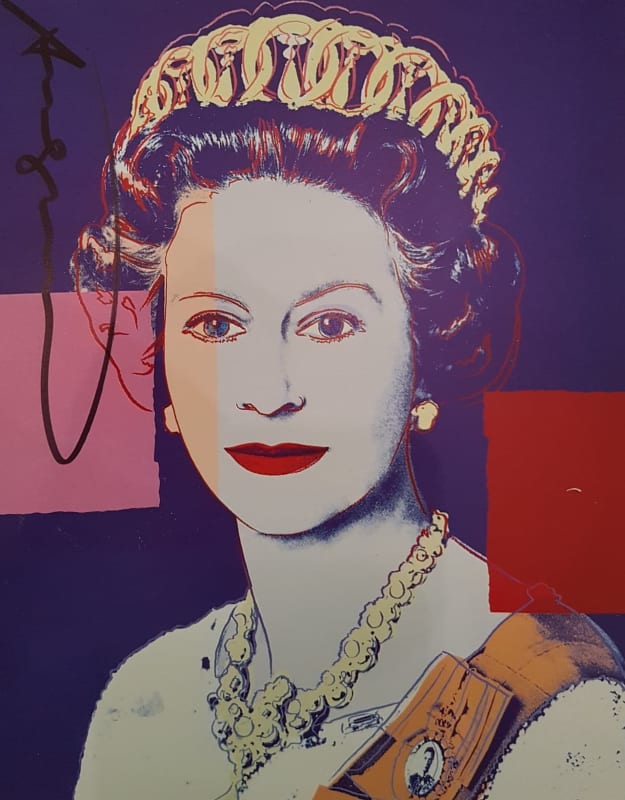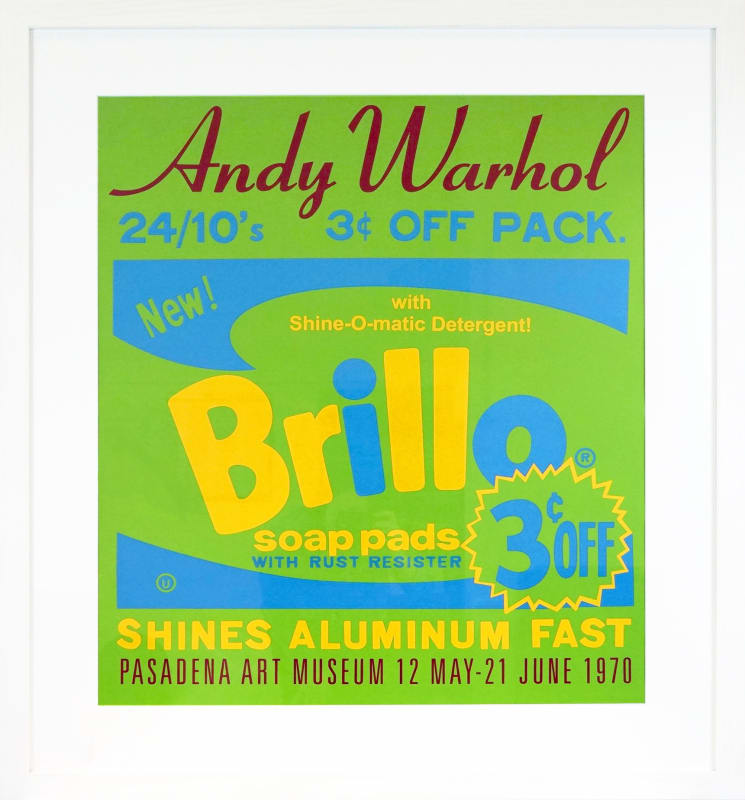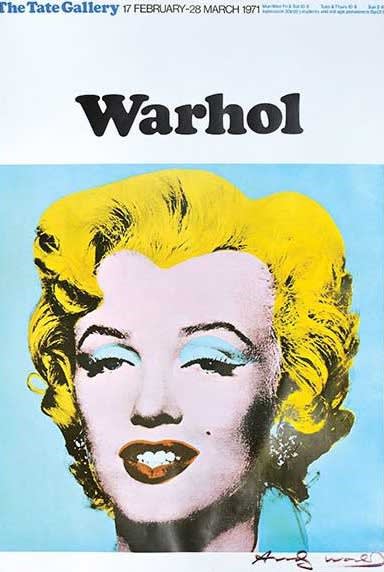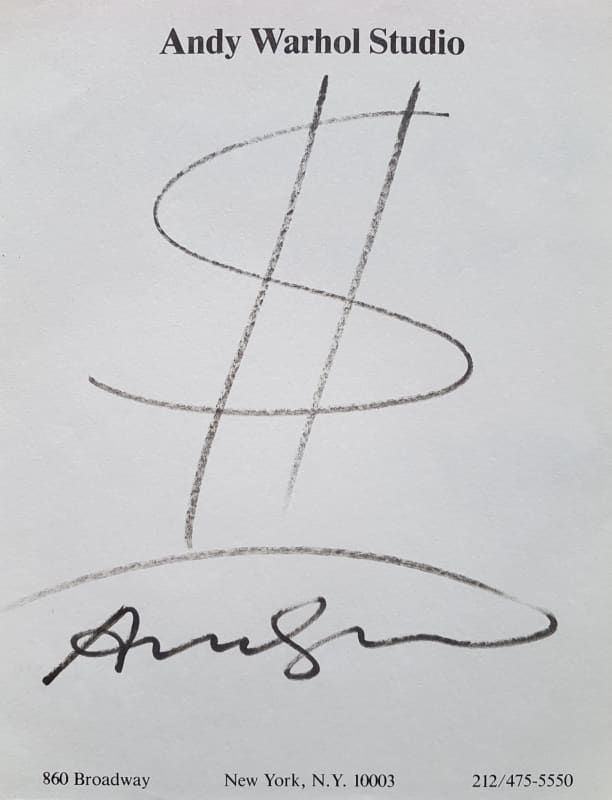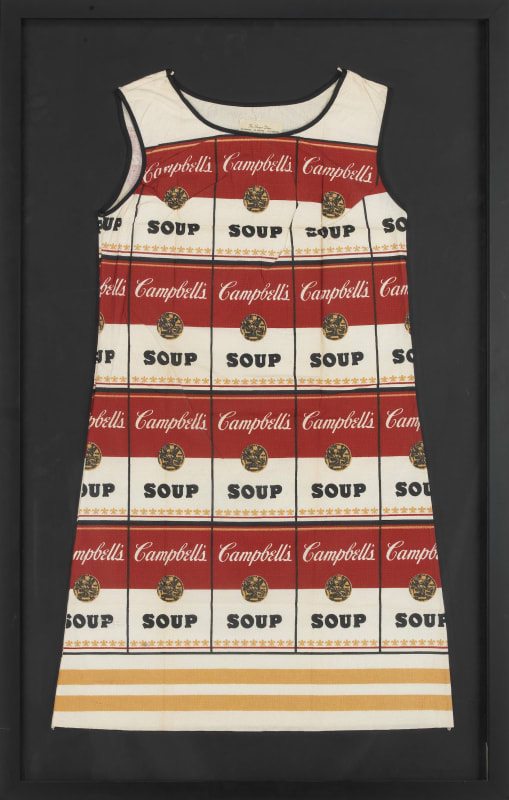This is Warhol's world...we're just living in it. He understood contemporary life in ways that we are still coming to terms with; his prediction that "in the future, everyone will be world-famous for fifteen minutes" was extraordinarily prescient, and he essentially came to define the idea of the contemporary megastar artist.
There are few things more highly-prized in the 21st century than the opportunity to live with an original work by Warhol. Since his death in 1987 the price of his work at auction has increased on average by a staggering 3400%. Auction sales of his work fetched $348 million in 2021, making him the third most highly-traded artist globally.
At Hidden, we are proud to hold an outstanding collection of original works by Warhol. Keep reading to find out about some of the stars of our collection - images of each can be found in the slideshow to the right.
Andy Warhol, Queen Elizabeth II, from the original exhibition cataloge for 'Reigning Queens', 1985
Warhol's enduring fascination with celebrity found its apotheosis in the 1985 portfolio "Reigning Queens". A passionate admirer of monarchy and its enigmatic power, he created four different portraits for each of the four queens reigning at the time: Elizabeth II of the United Kingdom, Beatrix of the Netherlands, Margarethe II of Denmark and Ntombi Twala of Swaziland. This image was signed on the opening night of their original exhibition at the Leo Castelli Gallery in New York. A more perfect synthesis of fame, glamour and celebrity is hard to imagine. You can almost hear the champagne popping and imagine Warhol holding court as the Sun King of the New York art scene.
The Reigning Queens portfolio is one of the most desirable series of prints that Warhol ever produced, with Elizabeth II being the most coveted of the four subjects. Ever fascinated by the interplay between commerce and art, this page from the opening night catalogue straddles the line between both of Warhol's spiritual reference points. As a hand-signed depiction of one of his most beloved images it ticks every box for admirers of this ever-relevant and investable titan of 20th century culture.
Andy Warhol, Pasadena Art Museum - Brillo Soap Pads, 1970
Warhol famously summarised the American consumer experience thus: “A coke is a coke and no amount of money can get you a better coke than the one the bum on the corner is drinking. All the cokes are the same and all the cokes are good. Liz Taylor knows it, the President knows it, the bum knows it, and you know it.” Warhol was fascinated by the democratic power of branded objects and the way they permeated every level of society. His Brillo boxes are some of his most iconic works, produced as life-size replicas of the original supermarket packaging using plywood, paint and silkscreen ink. This poster is a special colour variant produced to accompany a major exhibition at the Pasadena Art Museum. He also created one hundred brand new Brillo boxes in plywood for the occasion.
Occupying the same iconic space as his Campbell's Soup Cans, Warhol's Brillo boxes represent a turning point in the development of American Pop Art and are some of the most important works of the 20th century. This poster is a testament to their power and verve. A vibrant and richly-inked silkscreen, it was produced in the artist's most familiar and beloved medium. One of these posters is held in the permanent collection of the Whitney Museum of American Art in New York, so its owner will be in good company!
Andy Warhol, The Tate Gallery: Warhol, 1971
Warhol's seminal retrospective at the Tate Gallery in 1971 was fronted by this poster featuring his most famous work. Having created his first paintings of Marilyn Monroe in 1962, he had begun to issue signed editions of her image in 1967. This poster captures Warhol at his artistic and cultural zenith.
As a piece of commercial advertising that blurs the boundaries of fine art, this piece neatly encapsulates Warhol's philosophy. No image is as synonymous with his work as that of Marilyn Monroe, or more sought after. This portrait is permanently imprinted on our collective consciousness and is highly desirable in any format.
Andy Warhol, Dollar Bill Drawing, c.1974 - 1984
In this fabulous drawing, Warhol distils all the elements of American pop culture down to their most simple expression. Fame, glamour, success, consumerism: all are contained within the simple dollar sign. Such was the appeal of this motif to the artist that in 1981 he created an acclaimed series of screenprints that sought to blur the boundaries between creative and commercial success until they were almost indistinguishable. This piece is drawn on a sheet of the headed notepaper used by Warhol in his studio - the "Factory". Four separate spaces served as the Factory at different times between 1963 and 1987. The address on the sheet indicates that this drawing was made at the third Factory, which Warhol occupied for ten years between 1974 and 1984. These were the years of Studio 54 and the international jet set, when the artist was at the height of his fame.
As an original drawing by one of the most bankable artists in the world, this piece would sparkle in any collection. It also comes with exceptional provenance, having been sourced from the gallery of John McWhinnie, a dealer of art and rare books who was closely associated with the Warhol crowd. A fixture of New York's downtown scene, he handled the archives of numerous cultural figures including Brigid Polk and Velvet Underground member Moe Tucker.
Andy Warhol, The Souper Dress, c.1968
Warhol's iconic 1962 exhibition of soup can paintings had brought him widespread fame. Selected New York socialites had begun to wear custom-made dresses bearing Warhol's design to gallery openings. Private commissions from the artist himself, they were never sold commercially and were incredibly exclusive.
These developments did not go unnoticed by the Campbell's Soup Company, who were keen to make the most of their newfound cult status. Combining the fad for paper dresses with Warhol's imagery, they launched a promotion in which anybody who sent them two soup labels and a dollar would be mailed a "Souper Dress" in return. The dresses could not be washed and were only intended to be worn once or twice. The hem could be cut to the preferred length by using the stripes at the bottom as a guide. The first of these dresses were made in 1966, when paper clothing was being heralded as the future of fashion. As it turned out, most wearers found that such items tore and creased far too easily to be practical, and the trend had largely run its course by the end of the decade.
Examples of the Campbell's "Souper Dress" are held in major museum collections across the globe. You can find them in MoMA (New York), The Metropolitan Museum of Art (New York), Fine Arts Museums of San Francisco, the Museum of New Zealand (Wellington), and the V&A (London).
Any questions? We are happy to help. Call: 0117 279 6402 or send us a message now.

